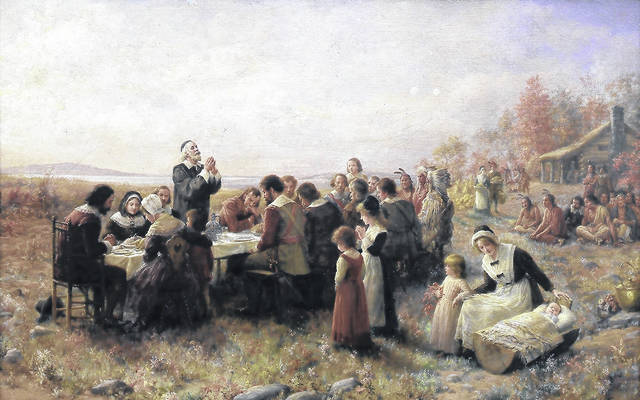
GREENVILLE — Those of us of a certain age may fondly recall the Schoolhouse Rock song “No More Kings.” In this animated feature, the Pilgrim ship Mayflower is depicted literally bumping up against a rock dated “1620.”
“The pilgrims sailed the sea
To find a place to call their own.
In their ship Mayflower,
They hoped to find a better home.
They finally knocked
On Plymouth Rock
And someone said, ‘We’re there.’
It may not look like home
But at this point I don’t care.”
While Schoolhouse Rock was a fabulous program for teaching 1970s- and 1980s-era children history, grammar, math and science, this abbreviated tale of the Pilgrims leaves out many facts about the founding of the Plymouth Colony.
As we have reached the 400-year mark of their landing in the new world, many myths about the Pilgrims, and their first Thanksgiving celebration in 1621, continue to remain embedded in the American consciousness to this day. Following are some interesting topics of discussion for your Thanksgiving Day gathering (if you wish to avoid politics):
Rocking it
According to the Pilgrim Hall Museum, the famous rock, inscribed with the date “1620,” is not mentioned in any contemporary references by the Pilgrims themselves.
“There are two primary sources written by the Pilgrims themselves describing the landing in Plymouth in 1620, William Bradford’s journal Of Plymouth Plantation and the 1622 book popularly known as Mourt’s Relation. Both simply say that the Pilgrims landed. Neither mentions any rocks in their account of the landing. The first references to Plymouth Rock are found over 100 years after the actual landing,” states the museum’s website.
In fact, the 1620 date was not cut into the rock until 1880. Nonetheless, it remains an important, physical symbol of one of the earliest American settlements.
Speaking of settlements…
While the Pilgrim journey to the new world is a famous chapter in American history, the Plymouth Plantation was by no means the first location in North America established by white settlers.
The Norse (or if you prefer, “Viking”) settlement of L’Anse aux Meadows in Newfoundland, Canada, dates back to approximately A.D. 1000 and was eventually abandoned. After Christopher Columbus’ first voyage to the New World in 1492, many European powers sought to explore the new lands. In what would become the contiguous United States, quite a number of settlements were established by Spain, with many lasting very short times. The oldest continuously inhabited Spanish settlement in the current United States is St. Augustine in Florida, founded in 1565.
England was a little late to the settlement game. Its first broad attempt to settle in America, the Roanoke Colony in North Carolina in 1585, ended in the mysterious disappearance of all its settlers.
The founding of Jamestown in the Virginia Colony followed in 1607 and though oft-troubled, it survived. Plymouth’s founding came 13 years later.
No GPS, sorry
The original intended location of the founding of the Pilgrim colony was at the mouth of the Hudson River in modern-day New York State. However, storms drove the Mayflower more than 200 miles north, to present-day Massachusetts.
Bad weather persisted as the ship attempted to sail south, so the Pilgrims finally settled in Cape Cod, despite not having a royal charter to establish their home there.
The Dutch ended up being the beneficiaries of the Pilgrims’ bad luck with weather, settling the Hudson River area and establishing New Amsterdam Colony in 1624. Forty years later, the English took control of the colony and renamed it New York.
A varied menu
While contemporary accounts do mention “wild turkey” as one of the foods eaten during the first Thanksgiving in 1621, the Pilgrims and their Native American guests likely also feasted on venison, other wildfowl, corn — in the form of bread and porridge — beans, squash, carrots, as very possibly lobster, clams and mussels.
Mashed potatoes, gravy, pumpkin and sweet potato pies, and cranberry sauce were later additions to Americans’ “traditional” Thanksgiving meals.
While myths and legends persist, one thing remains true — the Pilgrims, with their bravery and steadfastness, established a path forward for what would eventually become the United States of America, a nation with “No More Kings.”


